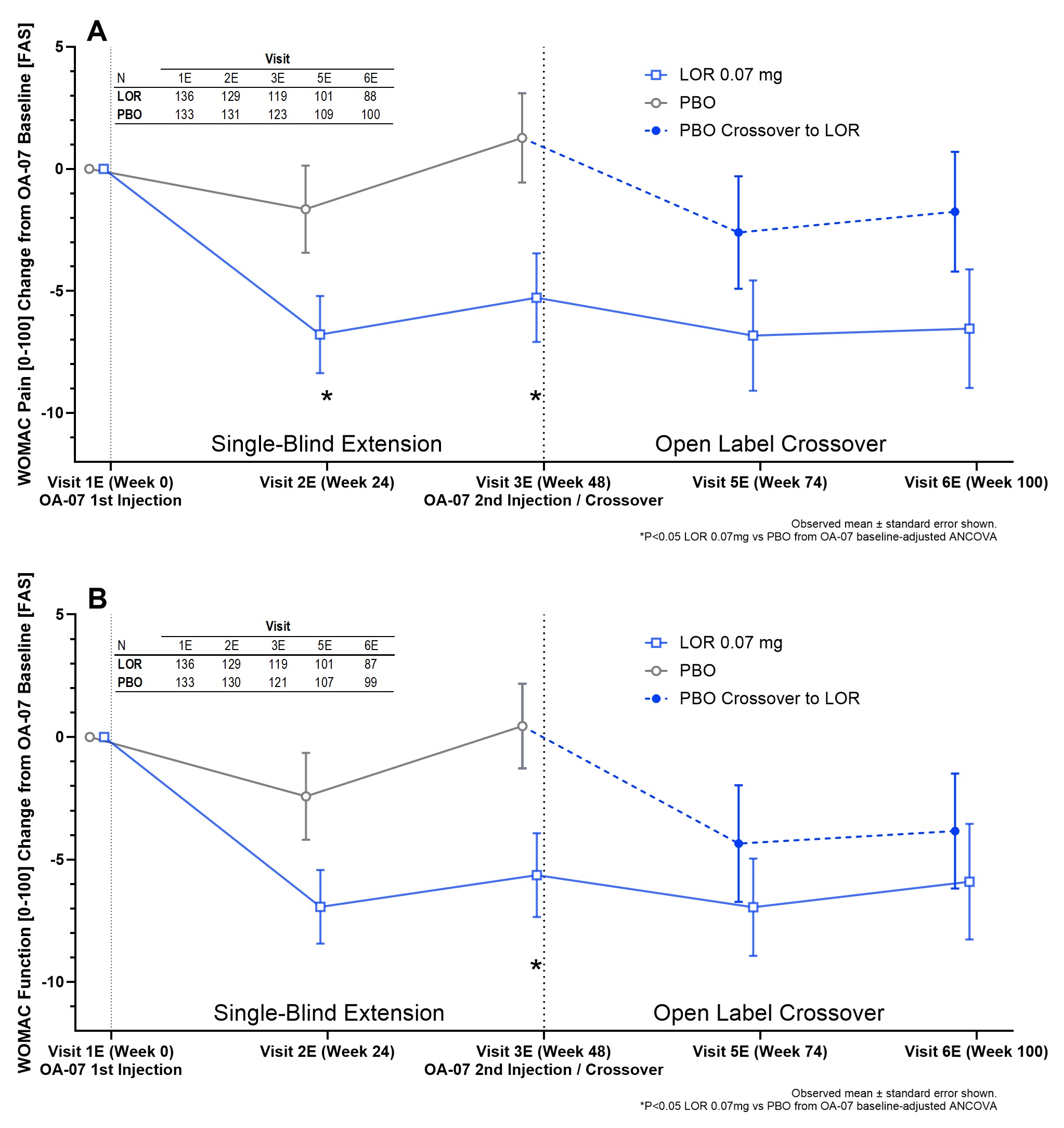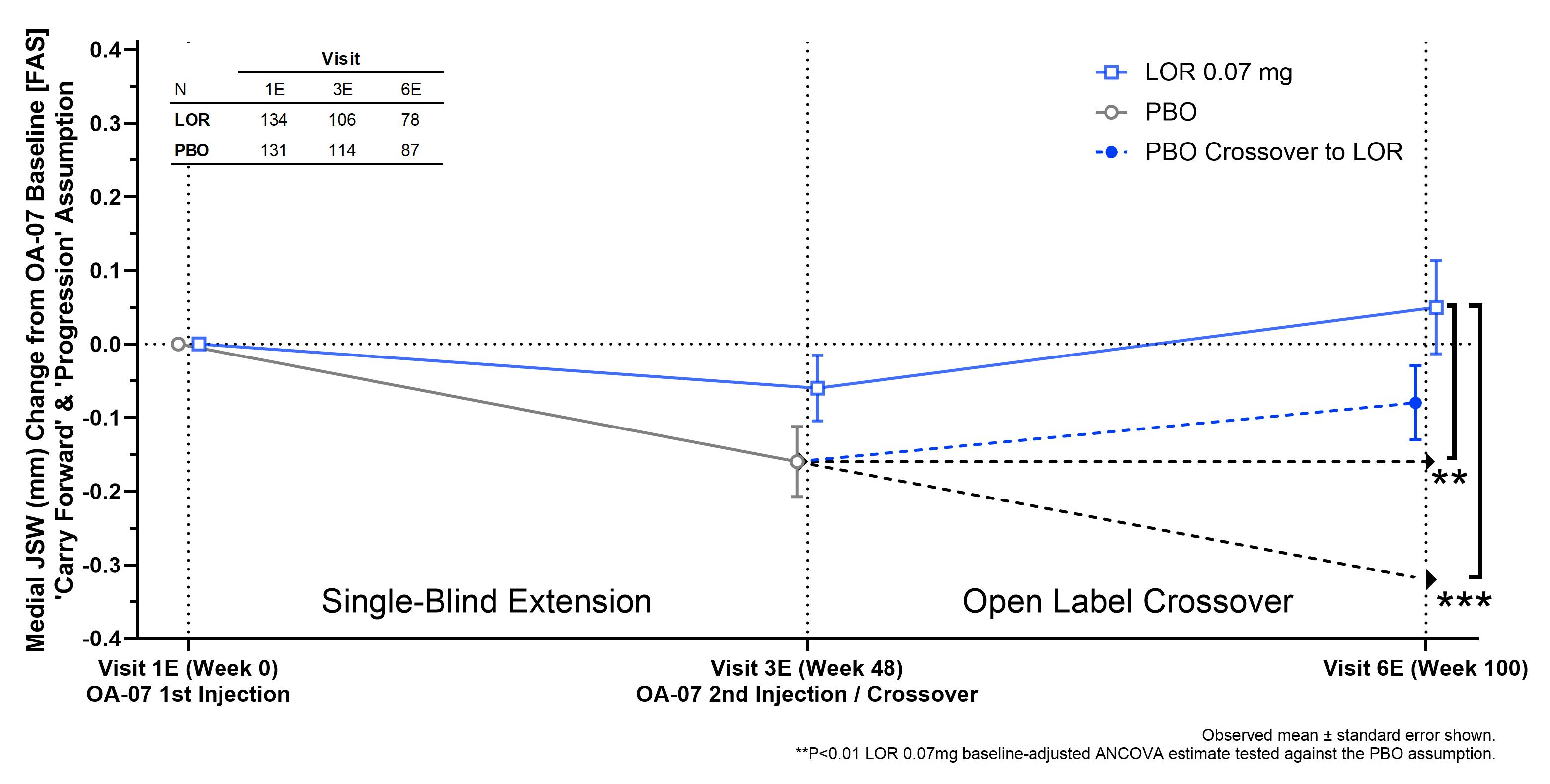Session Information
Session Type: Abstract Session
Session Time: 1:00PM-2:30PM
Background/Purpose: Knee OA has unmet need for safe and efficacious symptom and disease-modifying treatments. Lorecivivint (LOR), an intra-articular (IA) CLK/DYRK inhibitor thought to modulate inflammatory and Wnt pathways has previously appeared safe, improved patient-reported outcomes (PROs) and maintained radiographic medial joint space width (JSW) compared with placebo (PBO). A Phase 3 extension trial, OA-07 (NCT04520607), evaluated LOR safety and efficacy with medial JSW, WOMAC Pain and Function outcomes. This trial’s objective was to evaluate efficacy and safety of long-term, repeated LOR usage in patients with moderate-to-severe knee OA.
Methods: Enrolled patients had advanced knee OA (medial JSW 1.5-4 mm) and completed OA-11 LOR trial (NCT 03928184), a 1-year, single injection Phase 3 trial. At Week 0 of OA-07 Year 1 (blinded for participants and investigators), patients received a second, repeat injection according to original randomization (LOR / PBO; Figs. 1A, 1B, 2, Visit 1E). In OA-07 Year 2, all participants (still blinded to original treatment) entered an open-label ‘crossover’ phase receiving a LOR 0.07 mg (third) injection, (Figs. 1A, 1B, 2, Visit 3E). Baseline-adjusted ANCOVA estimated differences between LOR and PBO outcomes using OA-07 baseline measures. Treatment effect at Month 36 (Visit 6E) was estimated using marginal comparison from baseline adjusted ANCOVA to last PBO observation prior to crossover.
Results: 276 patients (mean age 61.0 ± 8.2 years, BMI 31.8 ± 4.9 kg/m2, female 62.7%, Kellgren-Lawrence Grade 3 45.3%, medial JSW 2.63 ± 0.69 mm, 67.4% bilaterally symptomatic) were enrolled. LOR appeared safe and well-tolerated with no major adverse event rate differences compared to PBO.
In Year 1 (blinded portion) of OA-07 , statistically significant improvements were observed for LOR vs PBO in WOMAC Pain [0-100] at Week 24, Visit 2E (∆=-4.52, 95% CI [-8.92, -0.13], P=0.044); Week 48, Visit 3E (∆=-5.19, 95% CI [-9.86, -0.53], P=0.029) (Figure 1a), and WOMAC Function [0-100] at Week 48 (∆=-4.86, 95% CI [-9.36, -0.35], P=0.035) adjusting for OA-07 baseline (Figure 1b). In Year 2 (crossover portion) of OA-07, all PBO patients receiving LOR showed mean improvements in WOMAC Pain and Function from Visit 3E observations.
Additionally, compared to the LOR arm, the PBO arm showed a numerical loss in medial JSW at Visit 3E, 24 months after first injection. At Visit 6E, 36 months after first injection, this loss was statistically significant compared to the last available PBO measure prior to crossover assuming a) no change (∆ = 0.22 mm, conservative scenario [P=0.001]) and b) progression (∆ = 0.38 mm, realistic scenario [P< 0.001]) (Fig. 2).
Conclusion: The OA-07 trial met its objective as repeat LOR 0.07 mg injections appeared to be safe and efficacious. Significant improvements in pain and function compared to PBO were seen at 6 and 12 months. Significant improvement in medial JSW was seen after repeat LOR injections compared to PBO. PBO patients who crossed to LOR treatment showed symptomatic and structural benefits after 12 months, providing further evidence of potential efficacy. LOR continues to show promise as a safe, disease-modifying knee OA treatment.
To cite this abstract in AMA style:
Yazici Y, Tambiah J, Swearingen C, McAlindon T. Radiographic and Pain Outcomes from a Phase 3 Trial (OA-07) Evaluating the Efficacy and Safety of Repeat Lorecivivint Injections over 3 Years in Subjects with Knee OA [abstract]. Arthritis Rheumatol. 2024; 76 (suppl 9). https://acrabstracts.org/abstract/radiographic-and-pain-outcomes-from-a-phase-3-trial-oa-07-evaluating-the-efficacy-and-safety-of-repeat-lorecivivint-injections-over-3-years-in-subjects-with-knee-oa/. Accessed .« Back to ACR Convergence 2024
ACR Meeting Abstracts - https://acrabstracts.org/abstract/radiographic-and-pain-outcomes-from-a-phase-3-trial-oa-07-evaluating-the-efficacy-and-safety-of-repeat-lorecivivint-injections-over-3-years-in-subjects-with-knee-oa/


